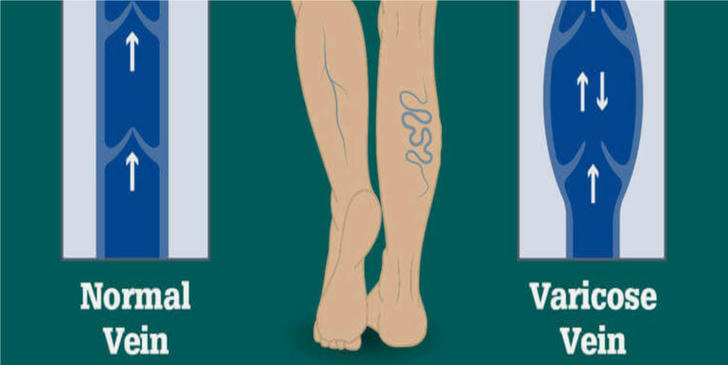How to Reduce the Risk of Varicose Veins through Diet and Exercise
Varicose veins are a common problem caused by dilated veins and poor blood return. It not only affects appearance but can also cause discomfort. By adjusting your diet and increasing exercise, you can effectively reduce the risk of varicose veins and improve blood circulation.

1.Risk Factors for Varicose Veins
The occurrence of varicose veins is often closely related to the following factors:
Standing or sitting for a long time: Whether standing or sitting for a long time, blood flow to the legs will be hindered, increasing the probability of varicose veins.
Genetic factors: If there is a history of varicose veins in the family, then the individual's risk of the disease will also be higher.
Aging: As you age, the elasticity of blood vessels decreases and the function of venous valves weakens, which leads to obstructed blood return.
Pregnancy: Changes in hormone levels in the body during pregnancy, as well as the pressure of the uterus on blood vessels, may cause varicose veins.
Poor eating habits and overweight: Obesity, a fiber-deficient diet, and high salt intake will increase the blood circulation burden on the lower limbs and increase the risk of varicose veins.
2.The relationship between diet and varicose veins
1. Foods that improve blood circulation
A healthy diet can help improve blood circulation and reduce the risk of varicose veins. Foods rich in antioxidants, vitamins C and E, such as citrus fruits, strawberries, grapes, nuts, etc., can help strengthen the health of blood vessel walls and reduce blood congestion.
2.Increase fiber intake
High-fiber foods, such as whole grains, beans, vegetables and fruits, can help prevent constipation and reduce abdominal pressure, thereby reducing the impact on leg veins. Constipation can cause increased abdominal pressure, which in turn affects blood return to the legs.
3.Choose healthy fats
Omega-3 fatty acids have anti-inflammatory effects, which can improve blood flow and reduce blood viscosity. Common foods rich in omega-3 fatty acids include salmon, flax seeds, walnuts, etc., and moderate intake can help maintain healthy blood flow.
4.Reduce salt intake
A high-salt diet can cause edema and fluid retention in the body, increasing the burden of varicose veins. Reducing the intake of processed foods and salty snacks and choosing natural foods can help reduce blood viscosity and reduce leg swelling.
5.Stay hydrated
Drinking enough water helps keep the blood flowing and avoids blood thickening caused by dehydration. Adequate water intake can help promote metabolism, reduce edema, and improve blood circulation in the legs.
3.The relationship between exercise and varicose veins
1.Exercise that promotes blood circulation
Regular exercise helps strengthen leg muscles and improve venous return. In particular, aerobic exercise such as walking, swimming, and cycling can speed up blood circulation and relieve the symptoms of varicose veins.
2.Benefits of specific exercises for venous health
Calf raises: Through the action of raising the heels, the calf muscles are strengthened, blood return is promoted, and venous dilation is reduced.
Toe circles: Sitting on a chair, with your feet flat and rotating your toes clockwise and counterclockwise, can effectively promote blood circulation in the ankles and calves.
Leg stretching and bending: Through simple leg stretching movements, muscle and vein pressure are relieved and blood return is improved.
3.Avoid sitting and standing for long periods of time
Sitting or standing for long periods of time can cause blood flow obstruction in the lower limbs and increase the risk of varicose veins. It is recommended to stand up and move for 5-10 minutes every hour, do some simple stretching exercises or walk to promote blood circulation.
4.A comprehensive diet and exercise strategy
1.A balanced diet combined with regular exercise
A healthy diet and regular exercise complement each other to help maintain an ideal weight and reduce pressure on the leg veins, thereby reducing the risk of varicose veins.
2.Develop a personalized plan
Develop a diet and exercise plan that suits your health and schedule. Gradually increasing your exercise and adjusting your diet can help achieve long-term results.
3.Persistence and patience
It may take time to change your diet and exercise habits, but if you stick to it for a long time, your body will gradually adapt and gradually reduce the risk of varicose veins. With consistent health management, you can significantly improve your vein health.
5.Case: Diet and exercise help reduce varicose vein symptoms
Case background: Lisa is a 38-year-old woman who works long hours in an office job and needs to sit for 8 hours a day. A few years ago, she began to notice significant varicose veins in her legs, especially after get off work, when her legs often felt heavy and swollen.
Solution: Lisa decided to improve her vein health through dietary changes and increased exercise. First, she reduced her salt intake and increased her intake of foods rich in antioxidants and fiber, such as fruits, vegetables, whole grains, and nuts. In addition, she walked for 30 minutes every day and did heel raises and stretches for her legs at least twice a day.
Results: After three months of hard work, Lisa found that her leg swelling was significantly reduced and her varicose vein symptoms were relieved. Her legs felt lighter and she felt less discomfort at work. Lisa said that she felt easier in her daily activities and no longer felt frequent leg pain and discomfort.
6.Conclusion
The occurrence of varicose veins is not only related to genetic factors, but also closely related to diet and exercise. By improving the diet structure and increasing the amount of exercise, the risk of varicose veins can be effectively reduced and existing symptoms can be relieved. Cases like Lisa prove that lifestyle changes can bring significant improvements. In order to have healthy legs and good blood circulation, it is recommended that everyone start paying attention to diet and exercise from today, and take active preventive measures to reduce the trouble caused by varicose veins.
